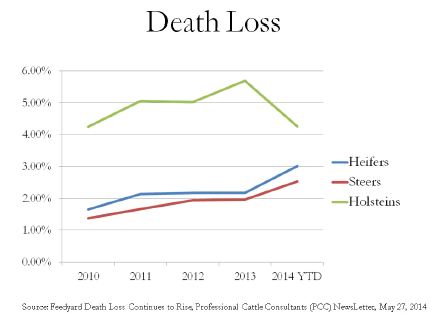



What Effect Does Genetics and Breed Have on Bovine Respiratory Disease
As a 'fairly heritable' condition, genetics and breeding work on Bovine Respiratory Disease (BRD) is well worthwhile given the strong value of cattle, says an industry leader.According to Larry Corah, Vice President of the Certified Angus Beef Brand, the new elevation in cattle prices has caused the industry to revisit many farming techniques to reduce death loss on farm.
Speaking at a couple of recent cattle conferences, Dr. Holly Neibergs, Washington State University animal geneticist, quantified that the cost per animal treated for bovine respiratory disease (BRD) is $204.10, writes Mr Corah.
She said this was due to losses in carcass quality, death and treatment costs. She further stated that BRD is estimated to affect 16.2 per cent of feedlot cattle, which amounts to a continuing economic disaster for the industry.
Something you likely did not know is that feedlot death loss has doubled since 2010 for beef-type steers and heifers (Holsteins were unchanged), according to data shared by Shawn Walters, Professional Cattle Consultants (see Figure).
So are there solutions? Well, something else you likely did not know is that BRD is fairly heritable and, through genetic selection, improvements may be coming soon.
Dr. Neibergs reported, that depending on how it is measured, BRD is between 17 per cent and 29 per cent heritable, which implies genetic selection could lead to a reduction in the problem. Her review of the literature shows differences between cattle breeds and sires, suggesting at least some direct BRD genetic relationship.
Genomic research has found more than 100 DNA-linked markers that have some linkage to BRD, and six or seven of those are showing considerable promise. This research conducted by scientists in a multi-state project offers hope that in the next couple of years we’ll be able to practice genetic selection for reduced BRD.
So what about a breed effect? Working with Iowa State University staff and the Iowa Tri-County Steer Carcass Futurity (TCSCF), we were able to look at breed effects (See Table).
The results were interesting and somewhat surprising. We first compared straight Angus steers and heifers to true F-1 crosses (half Angus – half second breed) and found no differences in morbidity/mortality rates. We then compared the straight Angus steers and heifers to those with a very low percentage Angus (9 per cent ) and found the straight Angus calves had a lower incidence of both sickness and death rate.




